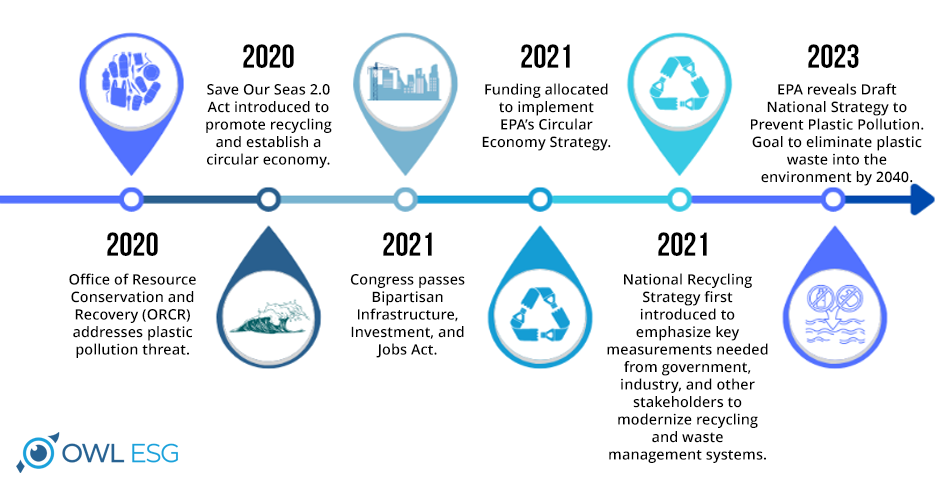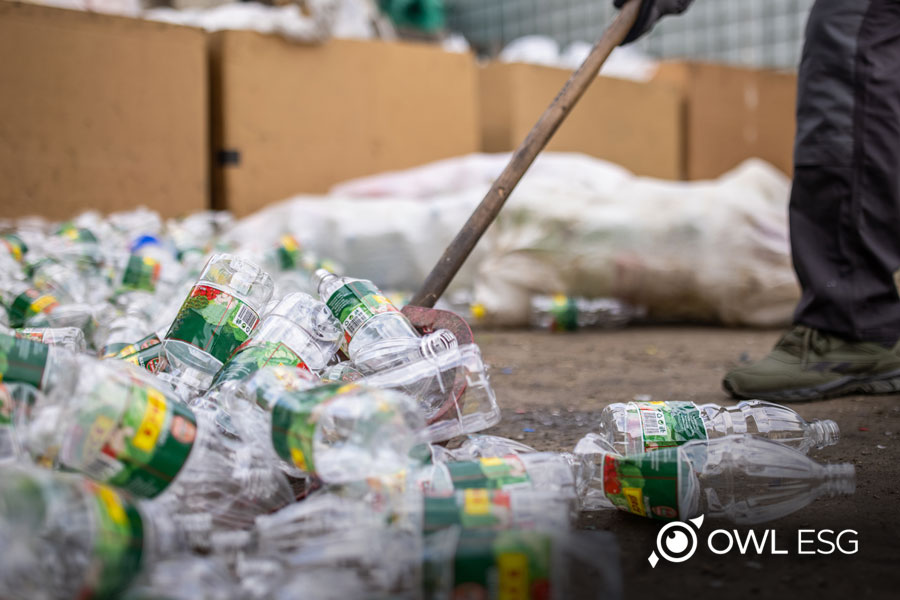Striking the Balance: EPA’s Plastic Recycling Emissions Regulations and the Quest for Sustainability
The EPA’s Role in Limiting Emissions
Amidst the recent political chaos in the U.S., regulators have played hot potato with restrictions around greenhouse gas (GHG) emissions and other environmental rules. While jumping from the Clean Power Plan to the Affordable Clean Energy Rule, several court cases, and about-faces by the EPA, one potentially significant change affecting emissions and plastics recycling never came to pass.
In June, the EPA rejected a lobbying campaign from the chemical industry around two types of plastics recycling, a reversal of its own Trump-era proposal. The proposal sought to loosen clean-air rules related to “pyrolysis” and “gasification,” two chemical-based methods for “advanced” recycling of plastics.

Both processes were generally considered “incineration” for the past 30 years, meaning that they were subject to regulatory guidance under the federal Clean Air Act, with strict emissions limitations. In August of 2020, the EPA proposed a rule in line with industry lobbying efforts, changing this designation. They argued, specifically, that there isn’t enough oxygen involved in the pyrolysis process to qualify as combustion, therefore not meeting the regulatory criteria for being classified as incineration.
Investors across various sectors and companies within the plastic value chain face both risks and opportunities due to the environmental and societal impacts arising from plastic production, usage, and disposal. A report from Principles for Responsible Investment (PRI) identifies key global challenges for plastics.
- Since the 1960s, global plastic production and consumption have surged by over 20-fold. Presently, packaging accounts for 40 percent of global plastics production, with 95 percent being single-use items.
- Despite rising plastic demand, the ineffective global waste management system hinders growth in production and consumption. Consequently, less than 20 percent of plastic waste gets recycled, leading to pollution in natural ecosystems, including rivers and oceans.
Throughout the plastic value chain, significant GHG emissions are produced during production, usage, and disposal. Research by the Center for International Environmental Law (CIEL) warns that GHG emissions could reach 10-13 percent of the remaining carbon budget by 2050—aligning with the United Nations Framework Convention on the Climate Change Paris Agreement’s 1.5-degree goal.
The EPA’s May 24 reversal of stance reinstates the “incineration” categorization, and once again enforces strict emission regulations on pyrolysis and gasification according to the federal Clean Air Act.
The industry has argued that these processes are necessary to effectively address the growing plastics crisis, especially when it comes to recycling types of plastic that are otherwise difficult to break down. Lobbying groups are looking to pyrolysis as a “way to convert plastic waste into synthetic gases, char residue, and a type of oil that can then be turned into fuel or chemical feedstocks.” Further, it provides an alternative to conventional mechanical methods like shredding, melting, and remolding the waste into new products.
However, the proposal to relax the rules was met with heavy pushback, particularly from Congressional Democrats (who eventually achieved their goal under the Biden EPA), arguing that both pyrolysis and gasification constitute a type of combustion, which could pose health hazards. Moreover, 35 lawmakers wroteto the EPA stating that “instead of leading to the recovery of plastic and supporting the transition to a circular economy, pyrolysis and gasification lead to the release of more harmful pollutants and greenhouse gases.”
Further groups argued that the change was not necessary to foster responsible plastics recycling, stating pyrolysis and gasification “require large amounts of energy and emit significant pollutants and greenhouse gases to turn discarded plastics into oil or fuel, or chemicals such as benzene, toluene and xylene, synthetic gases and a carbon char waste product.”
Understanding the Plastic Recycling Emissions Challenge
Plastic recycling has long been hailed as an environmentally friendly solution to the mounting plastic waste problem. However, plastic recycling facilities emit GHG and other pollutants during various stages, including collection, sorting, cleaning, reprocessing, and transportation. These emissions, if left unaddressed, can hinder progress towards a sustainable future, and present a competing interest with attempts to recycle discarded plastics.
Plastic recycling has long been hailed as an environmentally friendly solution to the mounting plastic waste problem. However, plastic recycling facilities emit GHG and other pollutants during various stages, including collection, sorting, cleaning, reprocessing, and transportation. These emissions, if left unaddressed, can hinder progress towards a sustainable future, and present a competing interest with attempts to recycle discarded plastics.
Impact on Emissions Reduction

The EPA’s emissions limitations for plastic recycling, and recycling more broadly, have led to a considerable reduction in GHG emissions and other pollutants. In 2015, the EPA developed the Waste Reduction Model (WARM) (updated in 2015) to assist solid waste planners and organizations in estimating GHG emission reductions resulting from various waste management practices.
By holding recycling facilities accountable for their environmental impact, the regulations encourage them to adopt innovative technologies like carbon capture and storage systems, energy-efficient machinery, and cleaner transportation options. Consequently, the overall carbon footprint of the plastic recycling industry has diminished significantly.
In December of 2018, The Association of Plastic Recyclers (APR) released a report comparing the life cycle impacts of using post-consumer resins to virgin materials. The study focused on three resins—polyethylene terephthalate (PET), high-density polyethylene (HDPE), and post-consumer recycled (PP)—and analyzed factors like total energy consumption, water consumption, smog formation potential, and solid waste generated during the production of recycled resins. The findings show that utilizing recycled resins leads to reduced energy consumption and GHG emissions. Results demonstrated:
The findings revealed significant savings in many categories, leading APR to assert that companies can reduce their costs and environmental impact by integrating recycled materials into their new products.
Fostering a Comprehensive Plastic Life Cycle and Resource Conservation
Since the 1950s, only nine percent of plastics have re-entered the value chain through recycling or reuse. Addressing plastic pollution requires confronting challenges throughout the entire life cycle of plastic, encompassing design, production, consumption, and disposal. Several contributing factors are evident, including unsustainable consumption patterns, inadequate or ineffective legislation, inefficient waste management systems, and a lack of coordination between different sectors.
EPA rules on plastic recycling emissions limitations are instrumental in driving the transition towards a comprehensive life cycle for post-consumer packaging and other materials. Instead of the traditional linear model of “take, make, dispose,” an end-to-end plastic life cycle emphasizes the continuous reuse and recycling of materials. By imposing emissions restrictions, the EPA encourages manufacturers to design products with recyclability in mind, reducing the demand for virgin plastic and conserving valuable resources.
New legislation, initiatives, and unprecedented funding demonstrate Congress’s dedication to revamping and investing in recycling. Such efforts have been enacted since 2020.
Harmonizing Recycling and Emission Goals: Navigating Toward a Greener Future
In the ever-evolving landscape of environmental sustainability, the intersection of recycling practices and emission regulations stands as a pivotal juncture. As we navigate the complexities of waste management and emissions reduction, it becomes evident that striking a balance between these two critical aspects is essential. While recycling endeavors offer a glimmer of hope in tackling the mounting crisis of plastic waste, emissions regulations underscore the pressing need to curtail air pollutants that threaten our planet’s health.

The disputes surrounding processes like pyrolysis and gasification reveal the intricate interplay between environmental conservation and regulatory frameworks as well as conflicting goals. It’s key to recognize that the journey toward a greener future involves addressing both the disposal of waste and the mitigation of emissions. As we push forward, finding harmony between these two vital fronts will be instrumental in shaping a more sustainable and prosperous world for generations to come. Nonetheless, the plastic recycling industry’s ongoing challenges demand continuous collaboration between the EPA, private sector, and the public to ensure that emissions reduction and recycling efforts remain on an upward trajectory.




